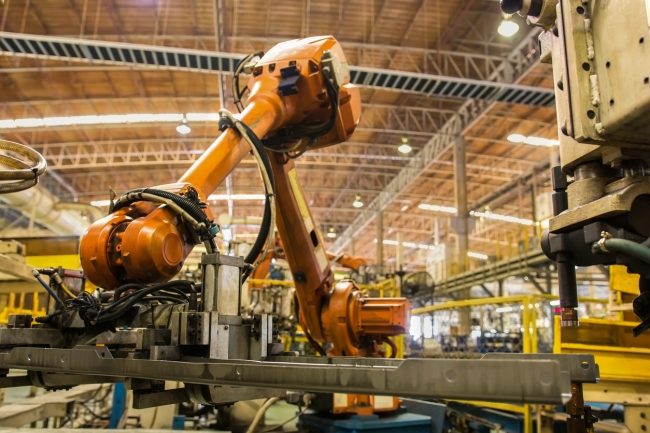2 minute read • published in partnership with IMechE
Automation and robotics in manufacturing & hazardous environments
Developments in Artificial Intelligence (AI) and robotics is at the forefront of technology news, whether it be improving manufacturing and retail processes, self-driving vehicles or exploring planets beyond earth. In light of this, it isn’t surprising that the UK government is providing £17.3 million of funding towards research into AI and robotics as part of its digital strategy.
The UK currently ranks above the global average in robotics adoption, with around 71 robots per 10,000 employees within the manufacturing sector. As the ninth largest manufacturing country in the world, meeting this increasing demand is changing the engineering market to fit requirements.

The UK currently ranks above the global average in robotics adoption, with around 71 robots per 10,000 employees within the manufacturing sector / Picture: Getty/iStock
The Institution of Mechanical Engineers caught up with Simon Jarvis, Head of Operations at Active8 Robots. ‘As the price of robots continues to drop and the cost of labour increases, it becomes unimaginable for manufacturers to not use automated solutions’ Simon explained. ‘We are already seeing major projects with ROI periods of less than a year.’
There is also new focus on the growing specialisms in the design, development and manufacturing of robotics and their components. This spans not just the manufacturing sector, but also those creating robotics for high hazard locations. Rich Walker, Managing Director at the Shadow Robot Company, specialises in grasping and manipulation developments for robotic hands.
‘There are many challenges faced by engineers when using robotics in hazardous environments, all of which, to an engineer, would be important in solving’ Rich described. ‘These usually revolve around control, sensors and communication, all essential components of telerobotics. Control involves getting the remote-controlled manipulator to perform in real-time without time delay. It should feel as natural as if the operator was using his or her own limbs.’
The increasing role of AI and machine learning of robotics is also a core consideration, bringing together both hardware and software experts. Understanding the limitations in data processing and how robots interact with their surroundings is vital when deploying new technologies. Rich explained that ‘sensors should not only process the environment accurately, [when] dealing with limited, distorted or noisy data, but relay this to the operator for reliable environmental insights. Augmented reality can help here as it can enhance the feedback information that the operator receives but the challenges are still there.’
With government investment and the support of newly established robotics hubs across the UK, we are set to see increasing development towards an automated future across engineering spheres. Ensuring the safety, efficacy and reliability of new technology whilst driving cutting-edge research will undoubtedly remain at the forefront of engineering news, and the Institution can’t wait to see what innovations will change the robotics landscape next.
Want to hear more?
Simon Jarvis will be speaking at the Robotics and Automation in Manufacturing seminar alongside speakers from Ocado Engineering, Airbus, The Manufacturing Technology Centre, OAL, BARA, Siemens and others.
Rich Walker will be speaking at the Robotics for Hazardous Environments seminar alongside speakers from Rolls-Royce, National Nuclear Laboratory, Airbus Defence and Space and Wood Group.